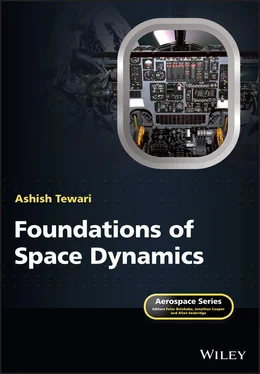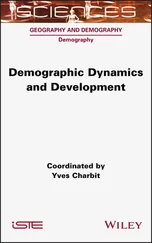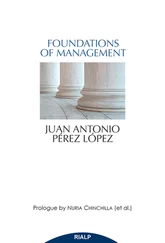1.1.1 Atmosphere as Perturbing Environment
When can the effects of the atmosphere be considered negligible so that space flight can come into existence? The atmosphere of a planetary body – being bound by gravity – becomes less dense as the distance from the planetary surface (called altitude ) increases, owing to the inverse‐square diminishing of the acceleration due to gravity from the planetary centre. For an atmosphere completely at rest, this relationship between the atmospheric density,  , and the altitude,
, and the altitude,  , can be derived from the following differential equation of aerostatic equilibrium (Tewari, 2006):
, can be derived from the following differential equation of aerostatic equilibrium (Tewari, 2006):
(1.1) 
where  refers to the atmospheric pressure, and
refers to the atmospheric pressure, and  the acceleration due to gravity prevailing at a given altitude. For a spherical body of radius
the acceleration due to gravity prevailing at a given altitude. For a spherical body of radius  , the gravity obeys the inverse‐square law discovered by Newton, given by
, the gravity obeys the inverse‐square law discovered by Newton, given by
(1.2) 
where  is the acceleration due to gravity at the surface of the body (i.e., at
is the acceleration due to gravity at the surface of the body (i.e., at  ). When Eq. (1.2)is substituted into Eq. (1.1), and the thermodynamic properties of the atmospheric gases are taken into account, the differential equation, Eq. (1.1), can be integrated to yield an algebraic relationship between the atmospheric density ,
). When Eq. (1.2)is substituted into Eq. (1.1), and the thermodynamic properties of the atmospheric gases are taken into account, the differential equation, Eq. (1.1), can be integrated to yield an algebraic relationship between the atmospheric density ,  , and the altitude,
, and the altitude,  , called an atmospheric model. For Earth's atmosphere, one such model is the U.S. Standard Atmosphere 1976 (Tewari, 2006), whose predicted density variation with the altitude in the range
, called an atmospheric model. For Earth's atmosphere, one such model is the U.S. Standard Atmosphere 1976 (Tewari, 2006), whose predicted density variation with the altitude in the range  km is listed in Table 1.1. It is evident from Table 1.1that the atmospheric density,
km is listed in Table 1.1. It is evident from Table 1.1that the atmospheric density,  , can be considered to be negligible for a flight for
, can be considered to be negligible for a flight for  km around Earth. A similar (albeit smaller) value of
km around Earth. A similar (albeit smaller) value of  is obtained on Mars at
is obtained on Mars at  km. Hence, for both Earth and Mars,
km. Hence, for both Earth and Mars,  km can be taken to be the boundary above which the space begins.
km can be taken to be the boundary above which the space begins.
The flight of a spacecraft around a large spherical body of radius  is assumed to take place outside the atmosphere, (such as
is assumed to take place outside the atmosphere, (such as  km for Earth and Mars), and is governed by the gravity of the body, with acceleration given by Eq. (1.2). Space‐flight trajectories are well defined orbits due to the simple nature of Eq. (1.2). However, since the atmospheric density in a very low orbit (e.g.,
km for Earth and Mars), and is governed by the gravity of the body, with acceleration given by Eq. (1.2). Space‐flight trajectories are well defined orbits due to the simple nature of Eq. (1.2). However, since the atmospheric density in a very low orbit (e.g.,  km on Earth), albeit quite small, is not exactly zero, the flight of a spacecraft can be gradually affected, to cause significant deviations over a long period of time from the orbits predicted by Eq. (1.2). This is due to the fact that the atmospheric forces and moments are directly proportional to the flight dynamic pressure,
km on Earth), albeit quite small, is not exactly zero, the flight of a spacecraft can be gradually affected, to cause significant deviations over a long period of time from the orbits predicted by Eq. (1.2). This is due to the fact that the atmospheric forces and moments are directly proportional to the flight dynamic pressure,  , where
, where  is the flight speed. The high orbital speed,
is the flight speed. The high orbital speed,  , required for space flight makes the dynamic pressure appreciable, even though the density,
, required for space flight makes the dynamic pressure appreciable, even though the density,  , is by itself negligible. The atmospheric drag (the force resisting the motion) causes a slow but steady decline in the flight speed, until the latter falls below the magnitude where an orbital motion can be sustained. Thus atmospheric drag can cause a low‐orbiting satellite to slightly decay in altitude after every orbit, and to ultimately enter the lower (dense) portions of the atmosphere, where the mechanical stress created by the ever increasing dynamic pressure, as well as the heat generated by atmospheric friction, lead to its destruction. Therefore, for predicting the life of a satellite in a low orbit, the atmospheric effects must be properly taken into account. Figure 1.1shows an example of the decay in the orbit of a spacecraft initially placed into a circular orbit of
, is by itself negligible. The atmospheric drag (the force resisting the motion) causes a slow but steady decline in the flight speed, until the latter falls below the magnitude where an orbital motion can be sustained. Thus atmospheric drag can cause a low‐orbiting satellite to slightly decay in altitude after every orbit, and to ultimately enter the lower (dense) portions of the atmosphere, where the mechanical stress created by the ever increasing dynamic pressure, as well as the heat generated by atmospheric friction, lead to its destruction. Therefore, for predicting the life of a satellite in a low orbit, the atmospheric effects must be properly taken into account. Figure 1.1shows an example of the decay in the orbit of a spacecraft initially placed into a circular orbit of  km around Earth. In this simulation obtained by a Runge‐Kutta method (Appendix A), the spacecraft is assumed to be a sphere of 1 m diameter, with a constant free‐molecular drag coefficient of 2.0 (Tewari, 2006). As seen in the figure, the altitude decays quite rapidly as the number of orbits,
km around Earth. In this simulation obtained by a Runge‐Kutta method (Appendix A), the spacecraft is assumed to be a sphere of 1 m diameter, with a constant free‐molecular drag coefficient of 2.0 (Tewari, 2006). As seen in the figure, the altitude decays quite rapidly as the number of orbits,  , increases. The initial average rate of altitude loss seen in Fig. 1.1– 1 km per 4 orbits – is likely to increase as the spacecraft descends lower, thereby encountering a higher density. When the spacecraft is placed in a circular orbit of
, increases. The initial average rate of altitude loss seen in Fig. 1.1– 1 km per 4 orbits – is likely to increase as the spacecraft descends lower, thereby encountering a higher density. When the spacecraft is placed in a circular orbit of  km, its altitude decays very rapidly, and it re‐enters the atmosphere after only 3.5 orbits (Fig. 1.2). Hence, the life of the spacecraft is only about 3.5 revolutions in a circular orbit of altitude 180 km above Earth. As Figs. 1.1and 1.2indicate, a stable orbit around Earth for this spacecraft should have
km, its altitude decays very rapidly, and it re‐enters the atmosphere after only 3.5 orbits (Fig. 1.2). Hence, the life of the spacecraft is only about 3.5 revolutions in a circular orbit of altitude 180 km above Earth. As Figs. 1.1and 1.2indicate, a stable orbit around Earth for this spacecraft should have  km at all times.
km at all times.
Читать дальше

 , and the altitude,
, and the altitude,  , can be derived from the following differential equation of aerostatic equilibrium (Tewari, 2006):
, can be derived from the following differential equation of aerostatic equilibrium (Tewari, 2006):
 refers to the atmospheric pressure, and
refers to the atmospheric pressure, and  the acceleration due to gravity prevailing at a given altitude. For a spherical body of radius
the acceleration due to gravity prevailing at a given altitude. For a spherical body of radius  , the gravity obeys the inverse‐square law discovered by Newton, given by
, the gravity obeys the inverse‐square law discovered by Newton, given by
 is the acceleration due to gravity at the surface of the body (i.e., at
is the acceleration due to gravity at the surface of the body (i.e., at  ). When Eq. (1.2)is substituted into Eq. (1.1), and the thermodynamic properties of the atmospheric gases are taken into account, the differential equation, Eq. (1.1), can be integrated to yield an algebraic relationship between the atmospheric density ,
). When Eq. (1.2)is substituted into Eq. (1.1), and the thermodynamic properties of the atmospheric gases are taken into account, the differential equation, Eq. (1.1), can be integrated to yield an algebraic relationship between the atmospheric density ,  , and the altitude,
, and the altitude,  , called an atmospheric model. For Earth's atmosphere, one such model is the U.S. Standard Atmosphere 1976 (Tewari, 2006), whose predicted density variation with the altitude in the range
, called an atmospheric model. For Earth's atmosphere, one such model is the U.S. Standard Atmosphere 1976 (Tewari, 2006), whose predicted density variation with the altitude in the range  km is listed in Table 1.1. It is evident from Table 1.1that the atmospheric density,
km is listed in Table 1.1. It is evident from Table 1.1that the atmospheric density,  , can be considered to be negligible for a flight for
, can be considered to be negligible for a flight for  km around Earth. A similar (albeit smaller) value of
km around Earth. A similar (albeit smaller) value of  is obtained on Mars at
is obtained on Mars at  km. Hence, for both Earth and Mars,
km. Hence, for both Earth and Mars,  km can be taken to be the boundary above which the space begins.
km can be taken to be the boundary above which the space begins. is assumed to take place outside the atmosphere, (such as
is assumed to take place outside the atmosphere, (such as  km for Earth and Mars), and is governed by the gravity of the body, with acceleration given by Eq. (1.2). Space‐flight trajectories are well defined orbits due to the simple nature of Eq. (1.2). However, since the atmospheric density in a very low orbit (e.g.,
km for Earth and Mars), and is governed by the gravity of the body, with acceleration given by Eq. (1.2). Space‐flight trajectories are well defined orbits due to the simple nature of Eq. (1.2). However, since the atmospheric density in a very low orbit (e.g.,  km on Earth), albeit quite small, is not exactly zero, the flight of a spacecraft can be gradually affected, to cause significant deviations over a long period of time from the orbits predicted by Eq. (1.2). This is due to the fact that the atmospheric forces and moments are directly proportional to the flight dynamic pressure,
km on Earth), albeit quite small, is not exactly zero, the flight of a spacecraft can be gradually affected, to cause significant deviations over a long period of time from the orbits predicted by Eq. (1.2). This is due to the fact that the atmospheric forces and moments are directly proportional to the flight dynamic pressure,  , where
, where  is the flight speed. The high orbital speed,
is the flight speed. The high orbital speed,  , required for space flight makes the dynamic pressure appreciable, even though the density,
, required for space flight makes the dynamic pressure appreciable, even though the density,  , is by itself negligible. The atmospheric drag (the force resisting the motion) causes a slow but steady decline in the flight speed, until the latter falls below the magnitude where an orbital motion can be sustained. Thus atmospheric drag can cause a low‐orbiting satellite to slightly decay in altitude after every orbit, and to ultimately enter the lower (dense) portions of the atmosphere, where the mechanical stress created by the ever increasing dynamic pressure, as well as the heat generated by atmospheric friction, lead to its destruction. Therefore, for predicting the life of a satellite in a low orbit, the atmospheric effects must be properly taken into account. Figure 1.1shows an example of the decay in the orbit of a spacecraft initially placed into a circular orbit of
, is by itself negligible. The atmospheric drag (the force resisting the motion) causes a slow but steady decline in the flight speed, until the latter falls below the magnitude where an orbital motion can be sustained. Thus atmospheric drag can cause a low‐orbiting satellite to slightly decay in altitude after every orbit, and to ultimately enter the lower (dense) portions of the atmosphere, where the mechanical stress created by the ever increasing dynamic pressure, as well as the heat generated by atmospheric friction, lead to its destruction. Therefore, for predicting the life of a satellite in a low orbit, the atmospheric effects must be properly taken into account. Figure 1.1shows an example of the decay in the orbit of a spacecraft initially placed into a circular orbit of  km around Earth. In this simulation obtained by a Runge‐Kutta method (Appendix A), the spacecraft is assumed to be a sphere of 1 m diameter, with a constant free‐molecular drag coefficient of 2.0 (Tewari, 2006). As seen in the figure, the altitude decays quite rapidly as the number of orbits,
km around Earth. In this simulation obtained by a Runge‐Kutta method (Appendix A), the spacecraft is assumed to be a sphere of 1 m diameter, with a constant free‐molecular drag coefficient of 2.0 (Tewari, 2006). As seen in the figure, the altitude decays quite rapidly as the number of orbits,  , increases. The initial average rate of altitude loss seen in Fig. 1.1– 1 km per 4 orbits – is likely to increase as the spacecraft descends lower, thereby encountering a higher density. When the spacecraft is placed in a circular orbit of
, increases. The initial average rate of altitude loss seen in Fig. 1.1– 1 km per 4 orbits – is likely to increase as the spacecraft descends lower, thereby encountering a higher density. When the spacecraft is placed in a circular orbit of  km, its altitude decays very rapidly, and it re‐enters the atmosphere after only 3.5 orbits (Fig. 1.2). Hence, the life of the spacecraft is only about 3.5 revolutions in a circular orbit of altitude 180 km above Earth. As Figs. 1.1and 1.2indicate, a stable orbit around Earth for this spacecraft should have
km, its altitude decays very rapidly, and it re‐enters the atmosphere after only 3.5 orbits (Fig. 1.2). Hence, the life of the spacecraft is only about 3.5 revolutions in a circular orbit of altitude 180 km above Earth. As Figs. 1.1and 1.2indicate, a stable orbit around Earth for this spacecraft should have  km at all times.
km at all times.










